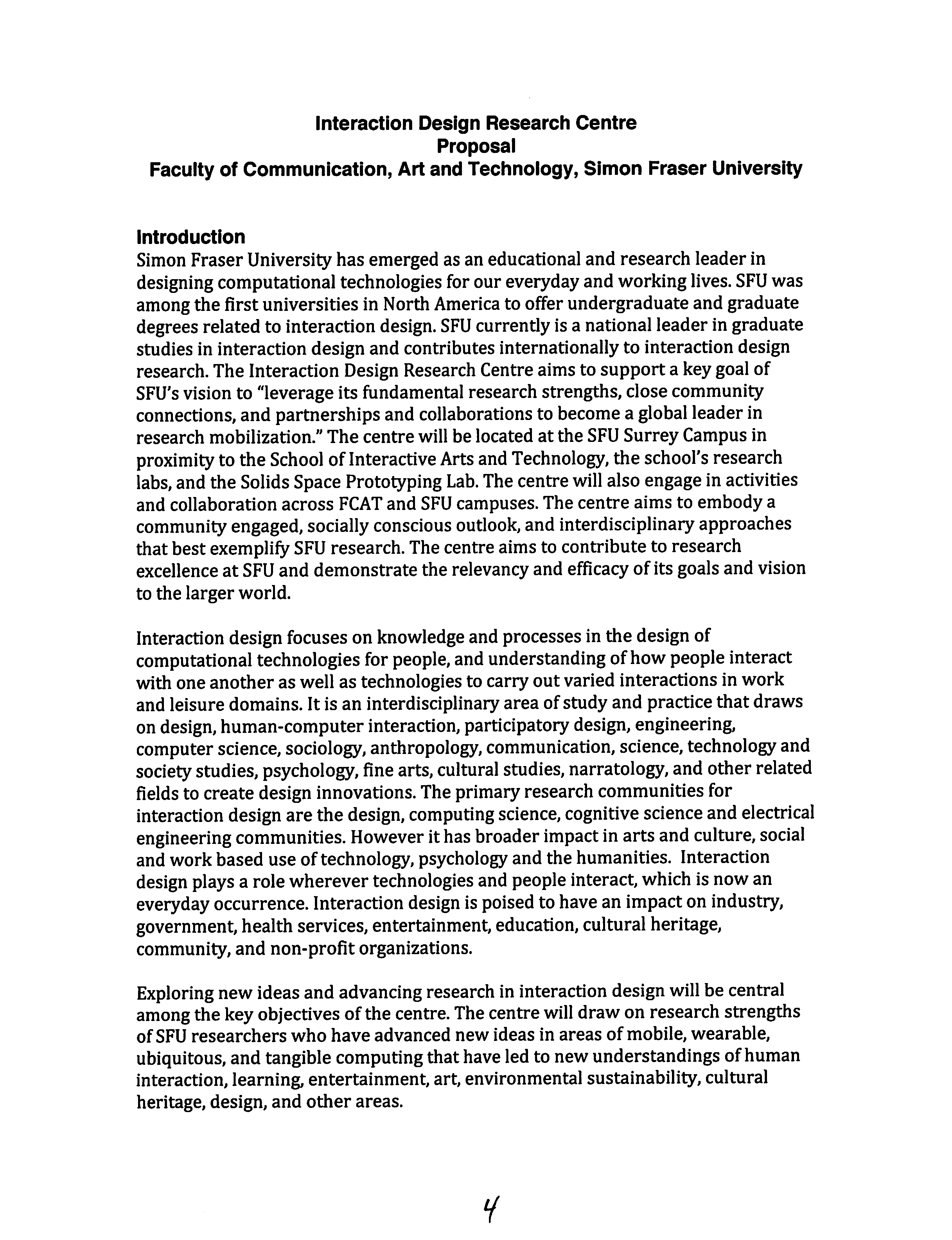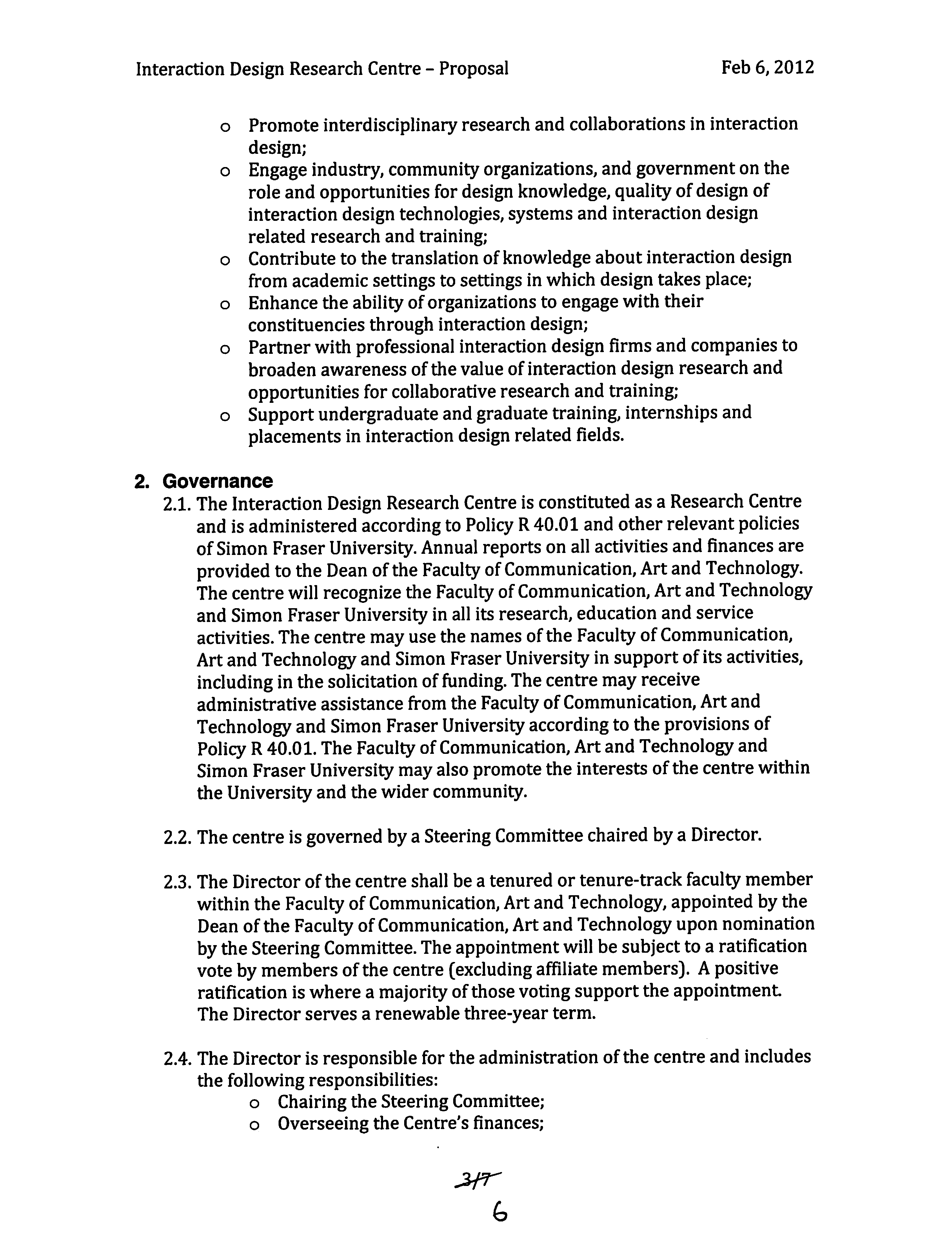SFU
MEMORANDUM
OIl'ICl'OI- THK VICK-PRKSIDKNT, ACADEMIC AND PROVOST
University Drive, Burnaby, BC
Canada V5A 1S6
TEL: 778.782.3925
FAX: 778.782.5876
attention
Senate
date
May 22,2012
from
Jon Driver, Vice-President, Academic and
pages
1/1
Provost, and Chair, SCUP
Faculty of Communication, Art and Technology: Interaction Design Resea^d
(SCUP 12-10)
RE:
S.12-86
vpacad@sfu.ca
vvww.sfu.ca/vpacadfinic
At its May 16, 2012 meeting SCUP reviewed and approved the proposal, fori the establishment of the
Interaction Design Research Centre.
Motion:
That Senate approve the proposal for the establishment of the Interaction Design Research Centre as a
Centre for a five year term.
end.
c: R. Wakkary
SIMON FRASER UNIVERSITY
engaging the world
Norbcrt H. Haunerland, Ph.D.
Associate Vice-President, Research
Professor of Biological Sciences
MAILING ADDRESS
8888 University Drive
Burnaby BC Canada
V5A 1S6
TEl.:
778.782.4152
fax: 778.782.4860
www.sfu.ca/vpresearch
SFU
OFFICE OF THE VICE-PRESIDENT, RESEARCH
ATTENTION Sarah Dench, Secretary
Senate Committee on University Planning (SCUP)
SCUP 12-10
1 FROM Norbert Haunerland, Associate Vice President,
Research
1 RE Interaction Design Research Centre
|
DATE April 23, 2012
Attached is a proposal from Dr. Ron Wakkary, for the establishment of the "Interaction
Design Research Centre".
I recommend approval as a Research Centre according to Policy 40.01. Once approved
by SCUP the proposal should be sent to Senate and the Board of Governors for
information.
Motion:
That SCUP approves the "Interaction Design Research Centre" as a Research Centre
for a 5 year term.
Dr. Norbert Haunerland
Associate Vice-President, Research
Attachment
C:
Ron Wakkary, School of Interactive Arts and Technology
J. Bowes, Director, School of Interactive Arts and Technology
SIMON I:RASER UNIVERSITY
THINKING OF THE WORLD
MEMORANDUM
ATTENTION
FROM
RE:
i-\u:n.TYoi'communication, vrtand'itoiiinoixkjy
Office of the Dean
I larbour Centre 7410
515 \X est IIastings Street,
Vancouver, BC
(Canada V6B 5K3
Tlil. 778.782.8790
www.fcat.sfu.ca
Norbert I taunerland, Associate Vice-
DATE
President, Research
Cheryl Geislcr, Dean, FCAT
PAGES
Proposal to establish Interaction Design Research CcntIC
March 26,2012
Please find attached a proposal to establish the Interaction Design Research Centre within the
Faculty of Communication, Art and Technology, which I fully support.
Under the guidance of an interim steering committee and the leadership of Professor Ron Wakkary,
the proposal has developed through wide consultation within
FCAT and has a clear governance
structure and mission. I have provided initial start-up funds and arranged for space on the Surrey
campus. The potential members and affiliate members listed in the proposal have all expressed an
interest in being involved.
SFU has international leaders in the area of interaction design and the Centre will provide a
platform for undertaking activities and gaining recognition. I expect it to enhance research and
provide a resource for bringing students into the community.
Please let me know if there is any additional information Ican provide.
\ph5ryl
Geisl^
)ean
Faculty of Communication, Art and Technology
SIMON F R A S E R U N 1V E R S I T Y
ENGAGING THE WORLD
3
Interaction Design Research Centre
Proposal
Faculty of Communication, Art and Technology, Simon Fraser University
Introduction
Simon Fraser University has emerged as an educational and research leader in
designing computational technologies for our everyday and working lives. SFU was
among the first universities in North America to offer undergraduate and graduate
degrees related to interaction design. SFU currently is a national leader in graduate
studies in interaction design and contributes internationally to interaction design
research. The Interaction Design Research Centre aims to support a key goal of
SFU's vision to "leverage its fundamental research strengths, close community
connections, and partnerships and collaborations to become a global leader in
research mobilization." The centre will be located at the SFU Surrey Campus in
proximity to the School of Interactive Arts and Technology, the school's research
labs, and the Solids Space Prototyping Lab. The centre will also engage in activities
and collaboration across FCAT and SFU campuses. The centre aims to embody a
community engaged, socially conscious outlook, and interdisciplinary approaches
that best exemplify SFU research. The centre aims to contribute to research
excellence at SFU and demonstrate the relevancy and efficacy of its goals and vision
to the larger world.
Interaction design focuses on knowledge and processes in the design of
computational technologies for people, and understanding of how people interact
with one another as well as technologies to carry out varied interactions in work
and leisure domains. It is an interdisciplinary area of study and practice that draws
on design, human-computer interaction, participatory design, engineering,
computer
science,
sociology,
anthropology,
communication,
science,
technology
and
society studies, psychology, fine arts, cultural studies, narratology, and otherrelated
fields to create design innovations. The primary research communities for
interaction design are the design, computing science, cognitive science and electrical
engineering communities. However it has broader impact in arts and culture, social
and work based use of technology, psychology and the humanities. Interaction
design plays a role wherever technologies and people interact, which is now an
everyday occurrence. Interaction
design is poised to have an impact on industry,
government, health services, entertainment, education, cultural heritage,
community, and non-profit organizations.
Exploring new ideas and advancing research in interaction design will be central
amongthe key objectives of the centre. The centre will draw on research strengths
of SFU researchers who have advanced new ideas in areas of mobile, wearable,
ubiquitous, and tangible computing that have led to new understandings of human
interaction, learning, entertainment, art, environmental sustainability, cultural
heritage, design, and other areas.
H
Interaction Design Research Centre - Proposal
Feb 6,2012
The centre will continue to draw on the interdisciplinary efforts of SFU researchers.
Interaction design research at SFU have drawn on theories of social sciences,
ethnography and social methods in design to develop new methods that highlight
the social uses of and contexts in which technologies are developed and used, and
engage stakeholders in ways that are democratic and empowering. Interactive and
contemporary arts research and practices have informed interaction design through
phenomenological, experiential and expressive investigations of interactive
technologies. Significant collaborations with the sciences like artificial intelligence,
cognitive science and user modeling haveled andwill continue to lead to
innovations in adaptive systems, visual analytics, and intelligent interactive systems.
Ethnographic work has been used to develop in depth understandingof many taken
for granted aspects of interactions, which must be supported in design.
In order to maintain the necessary and fruitful interdisciplinary aspects of
interaction design research, the centre will promote future interdisciplinary
research and partnerships.
The centre will also strive to close the gap between the current professional
practices and use of technologies and new knowledge in interaction design research
through collaborative research and training with partners beyond the academic
community.
The centre will aid organizations to better engage their communities and clients
through interaction design, and through such assistance, improve design and
economic returns.
Summary
The Interaction Design Research Centre will focus on research and community
engagement in the area of interaction design, the design of interactive technologies
for use by people. The centre will bringtogether researchers at SFU and external
partners with the aim of advancing new research in the field of interaction design.
The centre will engage local and national industry, community organizations, and
government to pursue research opportunities, solve problems, and enable training
related to interaction design. The centre will engage the professional interaction
design communities and will actively support undergraduate and graduate training,
internships and career placement.
1.
Purpose
1.1. The centre is dedicated to enhancing the efficacy, capacity, and quality of
interaction design research locally and internationally. Key objectives for
the centre include:
o Advance new ideas, methods, and concepts in interaction design;
o Expand the recognition, role and scope of interaction design in
industry, government, financial and other organizations;
Iff
5~
Interaction Design Research Centre - Proposal
Feb 6,2012
o Promote interdisciplinary research and collaborations in interaction
design;
o Engage industry, community organizations, and government on the
role and opportunities for design knowledge, quality of design of
interaction design technologies, systems and interaction design
related research and training;
o Contribute to the translation of knowledge about interaction design
from academic settings to settings in which design takes place;
o Enhance the ability of organizations to engage with their
constituencies through interaction design;
o Partner with professional interaction design firms and companies to
broaden awareness of the value of interaction design research and
opportunities for collaborativeresearch and training;
o Support undergraduate and graduate training, internships and
placements in interaction design related fields.
2. Governance
2.1. The Interaction Design Research Centre is constituted as a Research Centre
and is administered accordingto Policy R 40.01 and other relevant policies
of Simon Fraser University. Annual reports on all activities and finances are
provided to the Dean of the Faculty of Communication, Art and Technology.
The centre will recognize the Faculty of Communication, Art and Technology
and Simon FraserUniversity in all its research, education and service
activities. The centre may use the names of the Faculty of Communication,
Art and Technology and Simon Fraser University in support of its activities,
including in the solicitation of funding. The centre may receive
administrative assistance from the Faculty of Communication, Art and
Technology and Simon Fraser University according to the provisions of
Policy R 40.01. The Faculty of Communication, Art and Technology and
Simon Fraser University may also promote the interests of the centre within
the University and the wider community.
2.2. The centre is governed by a Steering Committee chaired by a Director.
2.3. The Director of the centre shall be a tenured or tenure-track faculty member
within the Faculty of Communication, Art and Technology, appointed by the
Dean of the Faculty of Communication, Art and Technology upon nomination
by the Steering Committee. The appointment will be subject to a ratification
vote by members of the centre (excludingaffiliate members]. A positive
ratification is where a majority of those voting support the appointment
The Director serves a renewable three-year term.
2.4. The Director is responsible for the administration of the centre and includes
the following responsibilities:
o Chairing the Steering Committee;
o Overseeing the Centre's finances;
Interaction Design Research Centre - Proposal
Feb 6,2012
o Recruiting members;
o Hiring personnel, including support staff and research assistants
dedicated to the Centre;
o Preparing the Centre's annual reports;
o Recruitand liaise with the Advisory Committee.
2.5. The Steering Committee consists of a minimum of 4 faculty members
includingthe Director. Normally, each member shall hold a continuing
appointment and full-time faculty appointment within SFU. Members of the
Steering Committee normally serve 1 year renewable terms appointed by
the Dean of the Faculty of Communication, Art and Technology, upon
nomination by the Steering Committee. Appointments to the Steering
Committee will be subject to a ratification vote by members of the centre
(excluding affiliate members). A positive ratification is where a majority of
those voting support the appointment. The role of the Steering Committee is
to determine the overall direction of the centre and oversee operations of
the Centre. The Steering Committee will normally meet once a term.
2.6. An Advisory Committee will consist of members from local, national and
international communities related to interaction design, representing
community
organizations,
industry,
interaction
design
profession,
external
academic research, and other related interests. The committee will advise on
direction of the centre and help broaden the interests and awareness of the
centre outside of SFU. The Advisory Committee will normally meet once a
year.
3. Funding
3.1. Funding for the Centre'sresearch, academic and administrative activities
comes from external grants, contracts, Faculty of Communication, Art and
Technology and related sources.
4. Members
4.1. Members of the centre will normally be limited to faculty, staff, and graduate
students at Simon Fraser University who make substantive ongoing
contributions to one or more of the centre'sresearch, education, service
activities, and funding. Members are expected to regularly engage in events
related to the centre. Members are eligible to vote to ratify the Director and
Steering Committee appointments, governance and other substantive
matters of the Centre. Membership is normally a renewable 1-year term and
approved by the Steering Committee.
4.2. Affiliate members include professionals, researchers, and graduate students
from Simon Fraser University, other universities, and organizations who are
engaged in substantive research, education, and service activities with the
centre and whose main affiliations are with organizations other than the
centre. Affiliate members are not normally eligible to vote on appointments
7
Interaction Design Research Centre - Proposal
Feb 6,2012
and other matters related to the Centre. Membership is normally a
renewable 1-year term and approved by the Director.
5. Interim Steering Committee
Pending ratification by members, the interim committee includes:
Dr. Ellen Balka, Communication
Dr. Lyn Bartram, SIAT
Dr. Carman Neustaetdter, SIAT
Dr.Thecla Schiphorst, SIAT
Dr. Ron Wakkary, SIAT
6. Potential Members and Affiliate Members
Dr.AlissaAntle,SIAT
Dr. Ellen Balka, Communication
Dr. Lyn Bartram, SIAT
Prof. Jim Bizzocchi, SIAT
Dr. John Bowes
Dr. Peter Chow-White, Communication
Dr. Henry Daniel, SCA
Prof. Steve DiPaola, SIAT
Dr.Arne Eigenfeldt, SCA
Dr. Halil Erhan, SIAT
Dr. Brian Fisher, SIAT
Prof. Martin Gotfrit, SCA
Dr. Diane Gromala, SIAT
Dr. Marek Hatala, SIAT
Dr. Kate Hennessy, SIAT
Dr. Frederick Lesage, Communication
Dr. Jan Marontate, Communication
Dr. Carman Neustaetdter, SIAT
Dr. Philippe Pasquier, SIAT
Prof. Cheryl Prophet, SCA
Dr. Bernhard Riecke, SIAT
Dr.Thecla Schiphorst, SIAT
Dr. Richard Smith, Communication
Russell Taylor, SIAT
Dr.
Ron Wakkary, SIAT
Andres Wanners, SIAT
Kenneth Zupan, SIAT
7.
Potential Labs, Centres and Academic Partners
• Active Space Lab, UC Irvine
• ATIC Design Lab, SFU
•
Bill Reid Centre for Northwest Coast Art Studies, SFU
• City of Surrey
8
Interaction Design Research Centre - Proposal
Feb 6,2012
Centre for Digital Media, GNWC
Centre for Policy Studies on Culture and Communities, SFU
Centre for the Study of Print and Media Cultures, SFU
Connections Lab, SFU
CPROST, SFU
Department of Information and Computing Sciences, Utrecht University
Dockl8, Cultural Space, Zurich, Switzerland
Engineering Physics, UBC
Everyday Design Studio, SFU
Faculty of Medicine, UBC
Genomics and Network Analysis Lab, SFU
GRAND, NCE
HCI Institute, CMU
Industrial Design Dept, KAIST
Integrated Electronic Arts (iEAR) Studios, Rensselaer Polytechnic
Institute
Intellectual Property Issues in Cultural Heritage, SFU
Interaction Centre, University College London
Interaction Design Dept, TUe, Eindhoven
Interactions Lab, University of Calgary
Intersections Digital Studio, (IDS) Emily Carr
iSpaceLab.com, SFU
ivizlab, SFU
laboratoire/art et societe/terrains ettheories (1/as/tt), Institut national
de recherche scientifique-urbanisation, culture et societe, Montreal
Laboratory for Ontological Research, SFU
Making Culture Lab, SFU
MAMAS lab (Metacreation, Agents and MultiAgent Systems), SFU
Mobile eHealth lab, UBC
MTIID, Music Technology, CalArts
Museum of Anthropology, University of British Columbia
NCSA - National Centre for Supercomputing Applications, eDream,
Department of Dance, University of Illinois at Champaign-Urbana UIUC
School of Engineering and Applied Sciences, Harvard/Artificial
Intelligence Research Group at Ben-Gurion University)
School of Informatics, Indiana University
Surrey Centre for the Arts
Social Computing & Artificial Intelligence Laboratory, MIT/Masdar
Institute
Science Lab, SFU
User-Centered Engineering Group, TU/e, Netherlands
Visual Analytics Research Lab, SFU
transept - transdisciplinary research centre for performance and
technology, SFU
8. Potential Industry and Community Partners
Mr*
Interaction Design Research Centre - Proposal
Feb 6,2012
Access to Media Education Society
Adobe
BC Cancer Agency
BC Cancer Research Centre
Bill Reid Gallery of Northwest Coast Art
Blast Radius
Car2go Vancouver
City of Richmond
City of Surrey
Cleverandson, Zurich, Switzerland
Credo Inc.
Crispin, Porter + Bogusky
Doig River First Nation
Electronic Arts
Farmboy Fine Arts
Fraser Health Authority
Frog Design
Genome BC
Genome Sciences Centre
Google
Habaneros
Ideo
Instant Coffee
Inuvialuit Cultural Resource Centre
Laban Institute of Movement Studies (LIMS) New York
LG Electronics
Microsoft Research
MIJI Dance Company
Museum of Vancouver
North Vancouver Museum and Archives
Provincial Health Services Authority
SAP
Science World at Telus World of Science
ScotiaBank Dance Centre
Smart Technologies
Surrey Art Gallery
Sto:lo Nation Research
and Resource Management Centre
Teenage Engineering
Terry Fox Research Institute
Tidal Interactive
Tyze Personal Networks
UBC Department of Film and Theatre
Vancouver Aquarium
Vancouver Coastal Health
Vancouver Emergency Management
Vancouver Opera
/O










